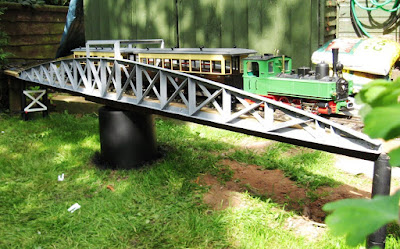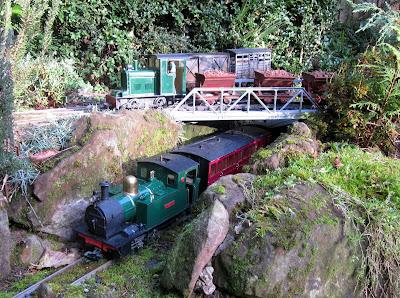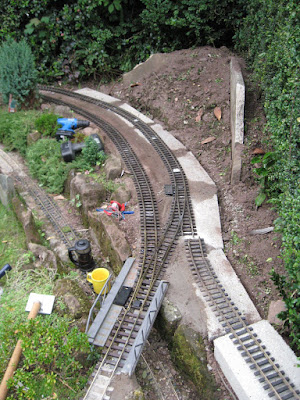 In reality, there are two rationales for the Peckforton Light Railway - the real one and the imaginary one. The real rationale explains why I set about building a railway in my garden and the imaginary rationale gives an account for why a narrow gauge railway might have been constructed in the Cheshire countryside at the turn of the 20th century to serve the local community.
In reality, there are two rationales for the Peckforton Light Railway - the real one and the imaginary one. The real rationale explains why I set about building a railway in my garden and the imaginary rationale gives an account for why a narrow gauge railway might have been constructed in the Cheshire countryside at the turn of the 20th century to serve the local community.The Real Rationale
Preamble
I can't remember how or why I became interested in railways - I just am. My first proper model railway was constructed by me when I was eleven years old using Triang 00 track and rolling stock bought from pocket, birthday and Christmas money. I then progressed to 00n3 narrow gauge, 009 narrow gauge and then back to 00 mainline model railways.Right from the start, I was fascinated by goods traffic handling. All my model railway layouts had one thing in common - they involved freight handling with varying degrees of sophistication; from simple dice rolling to, ultimately, a semi-randomised computer freight management program determining which wagons were moved and where.
 |
| One of my 00 layouts with punched cards and dice for managing freight movements |
The layout
My overarching rationale for the the layout was the need for:- a continuous run, to allow me to have something running while entertaining guests or doing the gardening or just for those occasions when I wanted to sit in a deck chair and watch at train trundling round;
- some sort of end-to-end or out-and-back running, for when I wanted to run it like a real railway;
- at least two stations, so I could run passengers trains and marshal freight to go to and from somewhere;
- future expansion, so the railway could be extended in phases as finances and time permitted.
However, I tired of this very quickly. There was very little additional operating potential beyond what I had had in the house with a terminus and fiddle yard.
So, I added another two intermediate stations - one which became Beeston Castle Station .......
...... and another which became Peckforton Station.
This added more operating opportunities as wagons could be transported to and from a wider range of origins and destinations.
However, the limitations of freight handling at the terminus very soon became apparent. The two sidings available simply weren't enough with my rapidly increasing amount of goods rolling stock. I therefore decided to extend the railway down the side of the garden to another (larger) terminus (See How I extended the railway)
This also provided me with an opportunity to add quarry/mine sidings with a 'hidden' link to the main terminus thereby enabling empty wagons to be exchanged for loaded ones - a cunning ploy which I had evolved on one of my 00 layouts.
 |
| The copper mine sidings with the 'hidden' connection to Beeston Market Station |
I kept the layout of each station fairly simple. The main terminus has plenty of goods sidings plus an engine shed. It is assumed that carriages are stored on the platform roads overnight. The three intermediate stations each have a passing loop and at least one siding, though these have grown in number over the years.
 |
| The original siding at Bulkeley |
Although not planned, all the original sidings were facing the Down direction of the line, which meant that shunting operations at the intermediate stations were best done as goods trains travelled Up the line. I have since learned that this was common practice on branch lines. Now I have added more sidings facing the Up direction, there is scope for shunting to be conducted in either direction.
 |
| New Up facing siding at Bulkeley |
Goods traffic
Simultaneously with the expansion to the second terminus, I hit upon the idea of setting my railway in a real location. Whilst on a walk along the Sandstone Trail through the Peckforton Hills, it dawned on me that the area would be ideal for a narrow gauge railway, to link the now redundant copper mines with the mainline railway station at Beeston Market. Not only would there be opportunities for mine traffic, the area has a couple of castles, natural springs and pleasant scenery - just the sort of attractions which would appeal to tourists from nearby Chester, Crewe, Liverpool and Manchester. (see The railway gains an identity) |
| The site of the PLR's Beeston Market Station |
I then set about deciding on the sorts of traffic which the line might have been expected to carry and bought, converted or constructed goods rolling stock to meet the projected traffic needs.
 |
| A pick-up goods train from the early days of the PLR |
When I first built my railway, I opted for 45mm gauge and off-the-shelf 'G Scale' models as I was in demanding full time employment and so needed something I could get up and running with the minimum of effort and time. At that time, Accucraft had not started production of their UK outline 16mm scale models and so I had to either make do with kits or modify non UK ready-to-run (RTR) models, or construct my own. It was apparent that open wagons were the mainstay of most railway rolling stock rosters and so, after constructing a couple from plasticard, I felt that casting the main components from resin would be a lot more cost- and time-effective (see How I made resin cast open wagons).
 |
| The first rake of resin cast open wagons behind the line's only loco at the time |
 |
| An LGB US style boxcar converted to a UK style closed van |
 |
| The rake of skip wagons behind my first scratchbuilt loco |
Locomotives
One advantage of of creating a hypothetical railway is that I have carte blanche when it comes to motive power. However, I have decided to set my railway in the early 1930s which restricts the range of locos to those which predate that period. I opted for early 1930s as I wanted an excuse for ex-Southwold locos to be running on my line (the SR closed in 1929). Other locos have been added to the roster as fancy takes me - though I have tried to ensure there is a plausible reason for each to have been acquired by the railway (see Real Rationale below). |
| Ex Southwold Sharp Stewart loco in PLR livery |
As with the rolling stock, when I started out in the garden the range of off the shelf UK based locos was restricted primarily to live steamers and maybe a couple of diesel outline locos - all of which seemed horrendously expensive for my meagre budget. Fortunately, GRS produced a small range of kits which enabled me to get started. However, after building a couple of their kits on LGB 0-4-0 ToyTrain motor blocks I reckoned I could have a go at making a loco from scratch - provided I used another LGB ToyTrain motor block as my success with making my own mechanisms was mediocre.
 |
| My first scratchbuilt loco - my interpretation of what a 3' gauge Fowler DM loco might have been like |
 |
| Loco No.1 (Peckett) and loco No.2 (Barclay) on shed (in its early position at Beeston Market |
Power
Initially, the railway was track-powered using a couple of DC transformer controllers. Despite moving over to a radio controller system, I found trying to run even three locos independently to be quite complicated as the LGB pointwork I was using wasn't self-isolating. This meant, for example, I couldn't have one train crossing another on a passing loop without having to install switched isolated track sections on each loop. So, I bit the bullet and invested in LGB's MultiTrain DCC system (See Digital Developments). This solved the problems of running more than one loco independently on the same tracks but didn't solve the another problem of unreliable and hesitant running associated with trying to draw power through the track.  |
| My DCC set-up as of Summer 2008 |
 |
| The only place I could find room for batteries in one of my smaller locos |
Operation
But why go to all this trouble, you might ask? Quite simply because, as indicated above, freight handling and hence shunting are what gives me the greatest satisfaction when running my railway. |
| The Down pickup goods about to depart Beeston Market in 2012 |
Now I have converted all my locos to battery power, I can focus on their slow and realistic movement through the pointwork at each station in the confident knowledge that I have absolute and precise control. I'm not saying that I have eliminated occasional derailments or mistakes when I turn the knob on the handheld controller the wrong way, but I do find that I can while away a good two or three hours of total concentrated effort in running my railway in what I consider to be a reasonably realistic way.
It takes me around two full days to run through one day's operations on the railway. It can take a good couple of hours to set up the railway at the start of a session and an hour to clear everything away at the end.
 |
| A rare occasion when I ran my railway two-handed. Andy came all the way from New Zealand to shunt the pickup goods! |
Infrastructure
One of the problems of constructing a complete railway system is that there is a lot of infrastructure which has to be built. Landscaping the garden and laying the track is only the first part of the process. Building the infrastructure surrounding the railway is a major undertaking - particularly as in my case most of the buildings have been scratchbuilt, though the majority of station buildings were kitbuilt. |
| A recent addition to the line - a brewery at Beeston Castle station - made from PVC foamboard |
 |
| The plank bridge before....... |
 |
| ..... and after. |
Don't get me wrong. I do think the infrastructure contributes to the overall ambience of the railway, but for me it's the last thing on the agenda. A good, non railway enthusiastic, friend of mine said on seeing the railway for the first time in its early stages - "There is a railway in your garden, rather than a garden in your railway." And I suppose that has always been my rationale. I wanted the railway to be integrated into the garden rather than take it over. I don't want to construct another Bekonscot. I like a bit of infrastructure around each station, but the gaps in between are there for the garden to take precedence. For the trains to become lost in the flora and reappear on occasions as the track emerges between bushes and small trees.
The garden
I am not a serious gardener. My mum and dad were. My mum looked after the flowers while my dad concentrated on the vegetables. I picked up a modicum of their expertise, but only in passing. My garden has evolved on Darwinian principles. If a plant is in the right place it will survive and if it doesn't it's clearly not in the right place!After landscaping the garden to accommodate the railway, I sought inspiration from other people's gardens and one which really took my fancy was planted out primarily with heathers and dwarf conifers. In the early stages, the garden was thus planted out.
Over the past fifteen years I have experimented with all manner of plants placing them wherever there seemed to be a space. My guiding principles have always been to choose plants which I think will not look out of place beside a 1:19 scale model train. As a consequence, I now have:
- Lonicera bushes which have been crudely trimmed to look like trees;
- Dwarf conifers which have survived from the first phase of planting;
- Hebe bushes which resemble miniature trees;
- Areas of groundcover, primarily Mind Your Own Business;
- Rocks covered in moss - which flourishes naturally in my north facing shady garden;
- A few miniature rhododendrons, which look like miniature flowering trees;
- A few alpines such as Herb Robert and Saxifrage which are a bit bush-like and have only very small flowers;
- Ferns which thrive in the shady corners;
- Ivy, which would take over the entire garden if not trimmed back periodically.
The Imaginary Rationale
Preamble
The Peckforton Light Railway is situated in the Cheshire countryside and runs between Beeston Market station where there is an interchange connection with the main Crewe to Chester Railway, and Bickerton at the foot of the Peckforton Hills.The line was constructed in 1896 as a three foot gauge Light Railway, principally to carry ore from the copper mines at Bickerton to mainline railway interchange sidings at Beeston and Tarporley Station. Spoil is also carried from the mines and loaded into canal boats at Beeston Castle Wharf on the Shropshire Union Canal.
When the line opened it had three steam locomotives - a Hunslet 0-4-0, a Pecket 0-4-0 and a Barclay 2-4-0. A Fowler diesel mechanical locomotive was acquired in 1926 to handle the increasing traffic from the copper mine when another rich seam was discovered. In 1930, two former Southwold Railway locomotives joined the line following the closure of the Southwold Railway.
 |
| Early view of Beeston Castle with Barclay and Fowler locos on duty |
Soon after the railway's construction, it was recognised that there was considerable potential for tourism especially when an enterprising local businessman opened a hotel and spa at Bulkeley where natural springs had been providing water for the local populace since Roman times. Excursion trains from Crewe, Chester, Liverpool and Manchester were organised to enable visitors to sample the delights of the countryside, to walk the footpaths in the Peckforton Hills, to visit the ruins of Beeston Castle and to take the waters at the hotel.
 |
| Contemporary postcard showing Beeston Lodge, the entrance to Beeston Castle |
The line flourished, even through the depression, and thanks to the patronage of Lord Tollemache, resident in Peckforton Castle, it acquired several more locomotives and stock as other narrow gauge railways sadly closed down.
The line was forced to close during the Second World War and rapidly fell into decline, particularly as its once loyal passengers and local tradesmen turned to road transport.
The last train ran in December 1945 and the track was lifted shortly afterwards.
 |
| Nature reclaiming the track after closure |
 |
| Source: https://www.flickr.com/photos/61090099@N04/26102523402 |
It was once rumoured that a preservation society might be formed to try and re-open a small part of the line but this has not been confirmed/
For more information see - A Short History of the Peckforton Light Railway









No comments:
Post a Comment